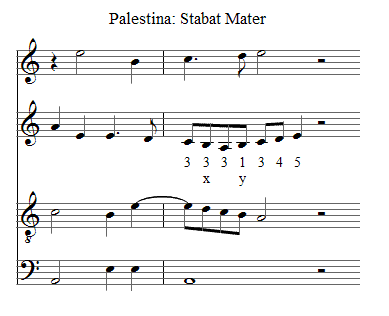APPENDIX A: VOICE LEADING OVERVIEW
Arpeggiation and Passing Notes
If we take an example of counterpoint where one voice moves at twice the rate of the other we get new possibilities in the voice leading patterns as we now have a degree of rhythmic independence added to the melodic independence. This is sometimes referred to as Second Species counterpoint. These possibilities are the arpeggio and the passing note.

In this kind of counterpoint, one part moves whilst another voice stays on the same note. Note: bar 3 breaks this pattern in order to make a better cadence (see fourth species later).
Each of the notes of the slower moving part (in semibreves) starts in consonance with the other part. As the faster moving part moves between one consonance and another, this produces two possible types of voice leading pattern which elaborate the underlying movement. These are the arpeggio and the passing note.
The arpeggio notes are indicated by "Arp" in the example. They result from movement from one consonant interval to another consonant interval. Arpeggio literally means "in the style of a harp" i.e. the notes of a chord played successively rather than concurrently. Whilst in 16th century polyphony, the horizontal voice leading is more important than the underlying chords, arpeggiation is important in analysis of later music where it opens up the possibility of elaborating underlying chords by parts moving from one note of a chord to another note of the same chord. In 16th century polyphony, this can alternatively be described as a "consonant skip" if we don't want to refer to chords.
An alternative for the moving part is to move by step onto a dissonant interval whilst the stationary part retains its original note. The movement must be completed by step in the same direction and on to a consonant note in order to return to normal consonant writing. This kind of discord is referred to as a passing note as it is created by a note passing between consonances. It fills the gap between two consonant notes a third apart. These are indicated by "P" in the example above. The passing note normally occurs on the weak beat and the consonance on the stronger beat. This creates an important way of deploying dissonant intervals, creates variety and results in an important kind of voice leading pattern which is very common in this period and in later periods of music. (In less frequent situations, the passing note dissonance can occur on the strong beat. This is normally referred to as an "accented passing note" but this is beyond the scope of this overview)
In this example, the passing notes produce dissonant intervals of a 7th and a 9th. It is possible to have similar examples for dissonant intervals of a 2nd and 4th (where the 4th is with the bass).
These two examples show how voice leading can be used to elaborate underlying patterns. These Arpeggios and passing notes are voice leading elaboration of the underlying consonant one to one movement. If we strip away this surface voice leading we are left with the following underlying one to one consonant movement:

Where three or more parts are involved, it is possible to have more than one passing note occurring at a time, sometimes moving in similar motion and sometimes in contrary motion. The following example contains both of these. The Alto and Tenor parts (which have crossed over) in the second bar shown, both contain passing notes. At 'x' they move in parallel thirds (as shown by the numbers). These fill in between the harmony notes of A C and E. At 'y' passing notes cross over at a unison, back to a third. In the process they swap notes. At the same time, the Soprano contains a passing note in 10ths with the Alto part so that there are three passing notes occurring simultaneously at 'y'. Note: the tenor part is performed an octave lower than written, as indicated by the "8" at the bass of the clef.

This example shows two common voice leading patterns: Firstly, parallel passing notes. These can occur in 3rds, 6ths or 10ths or combinations of these. Secondly, it shows the crossing of parts passing through a unison, resulting from passing notes. This results in the parts swapping notes (A and C here). This latter process can occur spread over an octave (or double octave) so that the movement crosses from a 6th to an octave to a 10th or vice versa. The two passing notes form an octave. This is sometime referred to as "voice exchange" because the voices exchange notes. These are both examples of common voice leading patterns that decorate the underlying harmony which, in this case, is an A minor chord.
Multiple passing notes can lead to the creation of whole chords which arise purely out of passing motion i.e. voice leading. This leads to chords such as the passing chord. Please follow the links to the glossary and Chapter 3 Part 3 for more information and examples of passing chords.
Next Topic: Auxiliary Notes and Linear Progressions

